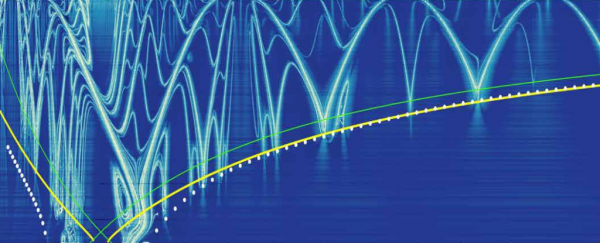Invisible structures generated by gravitational interactions in the Solar System have created a "space superhighway" network, astronomers have discovered.
These channels enable the fast travel of objects through space, and could be harnessed for our own space exploration purposes, as well as the study of comets and asteroids.
By applying analyses to both observational and simulation data, a team of researchers led by Nataša Todorović of Belgrade Astronomical Observatory in Serbia observed that these superhighways consist of a series of connected arches inside these invisible structures, called space manifolds - and each planet generates its own manifolds, together creating what the researchers have called "a true celestial autobahn".
This network can transport objects from Jupiter to Neptune in a matter of decades, rather than the much longer timescales, on the order of hundreds of thousands to millions of years, normally found in the Solar System.
Finding hidden structures in space isn't always easy, but looking at the way things move around can provide helpful clues. In particular, comets and asteroids.
There are several groups of rocky bodies at different distances from the Sun. There's the Jupiter-family comets (JFCs), those with orbits of less than 20 years, that don't go farther than Jupiter's orbital paths.
Centaurs are icy chunks of rocks that hang out between Jupiter and Neptune. And the trans-Neptunian objects (TNOs) are those in the far reaches of the Solar System, with orbits larger than that of Neptune.
To model the pathways connecting these zones, as TNOs transition through the Centaur category and end up as JFCs, timescales can range from 10,000 to a billion years. But a recent paper identified an orbital gateway connected to Jupiter that seems much quicker, governing the paths of JFCs and Centaurs.
Although that paper didn't mention Lagrange points, it's known that these regions of relative gravitational stability, created by the interaction between two orbiting bodies (in this case, Jupiter and the Sun), can generate manifolds. So Todorović and her team set about investigating.
They employed a tool called the fast Lyapunov indicator (FLI), usually used to detect chaos. Since chaos in the Solar System is linked to the existence of stable and unstable manifolds, on short timescales, the FLI can capture traces of manifolds, both stable and unstable, of the dynamical model it's applied to.
"Here," the researchers wrote in their paper, "we use the FLI to detect the presence and global structure of space manifolds, and capture instabilities that act on orbital time scales; that is, we use this sensitive and well-established numerical tool to more generally define regions of fast transport within the Solar System."
They collected numerical data on millions of orbits in the Solar System, and computed how these orbits fit with known manifolds, modelling the perturbations generated by seven major planets, from Venus to Neptune.
And they found that the most prominent arches, at increasing heliocentric distances, were linked with Jupiter; and most strongly with its Lagrange point manifolds. All Jovian close encounters, modelled using test particles, visited the vicinity of Jupiter's first and second Lagrange points.
A few dozen or so particles were then flung into the planet on a collision course; but a vast number more, around 2,000, became uncoupled from their orbits around the Sun to enter hyperbolic escape orbits. On average, these particles reached Uranus and Neptune 38 and 46 years later, respectively, with the fastest reaching Neptune in under a decade.
The majority - around 70 percent - reached a distance of 100 astronomical units (Pluto's average orbital distance is 39.5 astronomical units) in less than a century.
Jupiter's huge influence is not a huge surprise. Jupiter is, apart from the Sun, the most massive object in the Solar System. But the same structures would be generated by all the planets, on timescales commensurate with their orbital periods, the researchers found.
This new understanding could help us better understand how comets and asteroids move around the inner Solar System, and their potential threat to Earth. And, of course, there's the aforementioned benefit to future Solar System exploration missions.
But we may need to get a better fix on how these gateways work, to avoid those collision courses; and it won't be easy.
"More detailed quantitative studies of the discovered phase-space structures … could provide deeper insight into the transport between the two belts of minor bodies and the terrestrial planet region," the researchers wrote in their paper.
"Combining observations, theory, and simulation will improve our current understanding of this short-term mechanism acting on the TNO, Centaur, comet, and asteroid populations and merge this knowledge with the traditional picture of the long-term chaotic diffusion through orbital resonances; a formidable task for the large range of energies considered."
The research has been published in Science Advances.
